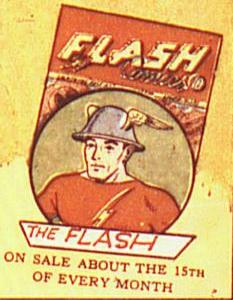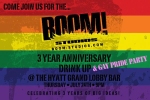Posts Tagged ‘Superman’
Superboy #1: Think Small
Posted on: November 3, 2010
 Ever since the Superman panel at SDCC 2010, my interest about Jeff Lemire’s Superboy had been piqued. After all, he’s proven with Essex County, The Nobody, and Sweet Tooth that he’s best writing about what happens in small-town America and, well, it doesn’t get more small-town America than Smallville.
Ever since the Superman panel at SDCC 2010, my interest about Jeff Lemire’s Superboy had been piqued. After all, he’s proven with Essex County, The Nobody, and Sweet Tooth that he’s best writing about what happens in small-town America and, well, it doesn’t get more small-town America than Smallville.
Directly following his stint as the headline act of Adventure Comics, Superboy has finally come to terms with the fact that he’s a composite of both Superman and Lex Luthor’s DNA. For right now, all he wants to do is get back to his roots, figure out what it is that makes Superman great, and support the widow Kent. Unfortunately, where there’s a superhero there’s bound to be supervillains popping up from time to time. With a little help from the Phantom Stranger (yesss) and Krypto, it’s up to Superboy to protect this small town from whatever it is the DCU decides to throw at it.
This is only Jeff Lemire’s second foray into the superhero genre (the first being his Atom back-up in Adventure Comics) but, in a familiar setting, it seems to work well for him. His teenagers actually talk like teenagers and, more impressively, his Phantom Stranger speaks just like he did in his 1969 John Broome series. And, as weird as it sounds, his own excitement for this title is at kid-on-Christmas levels (seriously, when Jon and I ran into him on the SDCC floor and asked about it, he immediately turned into the happiest guy in the convention hall).
Pier Gallo’s (Batman Confidential, Dark Reign: Hawkeye) art is gorgeous as well. Not only are the characters able to convey emotions well, but his backgrounds are amazing. While reading the story I actually felt like I was back in the Midwest, looking out over miles and miles of lush nothingness. Plus, as with the above panel, he manages to make lots of small actions take place in each panel without making it look ridiculously busy.
This book is definitely worth checking out, if not for the superb art, then for the what-the-hell worthy twist ending. Needless to say, so adding this title to my pull.
Superman v. The Great Depression
Posted on: August 8, 2010
“Fans come to me asking how this works or that works, and I say, ‘It’s a comic book. It’s not real.’ We already have a real world, why do you want fiction to be like that too?”
– Grant Morrison, 2010
Lately I’ve been reading a lot of Golden Age comics. I know there aren’t many of my generation who appreciate this stuff, and I’m positive I don’t “get it” the way my grandparents did, but the mixture of innocence, desperation, and humanity I find in these old stories is quite compelling.
When my generation imagines old comics we think of Super Friends, but for all its glitter the times of the Golden Age were rather bleak. Thanks to Captain America and Wonder Woman we think the heroes of that first era were framed against the backdrop of WWII. This is not true. While it is true that Superman, Batman, and others came to stand for the American Way their personae were not forged in flames of war, but in the embers of Depression.
“We can do it!” Rosie the Riveter said that for the first time in 1942. Superman debuted in 1938. We met Batman, Namor, and the Human Torch in 1939. Jay Garrick, Alan Scott, and the Spirit first appeared in 1940 alongside most of the Golden Age crew. Wonder Woman is the only major character to appear after Pearl Harbor, and she also joins Steve Rogers in color coordination. All of these heroes were born into an era scarred by record unemployment and rising crime as the country completed a full decade of economic depression.
People were starting to lose hope and this, my friends, is the world Superman needed to save.
Something I love about the early days of superheroes is the lack of super-villains. Oh, sure there were a few notable bad guys like the Joker and Wotan, but on the whole super-villains were exceptions to the norm of mob bosses, corrupt officials, and street thugs. This is what I meant when I said the Golden Age comics were desperate. America thought the problems of everyday life were bad enough to need heroes.
This reveals a real sense of hopelessness deep in the psyche of that generation. Rampant unemployment. Gang violence on the rise and crime organizing like never before. Times were desperate, and the Common Man felt he was quickly losing his place in the day-to-day life of America.
See, creators like Rob Kanigher and Len Wein saw comics as fantastical tales to thrill an audience with absurdity and bizarre scenarios. Jerry Siegel, Bill Finger, C. C. Beck, and Mart Dellon saw comics as a cathartic escape from the harsh reality of violence, corruption, and black-mail.
They saw comics as a weird mixture of hope and escape.
Never mind the crude drawings and clumsy dialogue. The heroes idolized by my grandfather didn’t need to fight aliens to have meaning. Superman was great because he could stop a lynching. We believed in the Green Lantern because he could expose a mob-boss who had framed an innocent man. These heroes didn’t protect us from the unknown; what they brought was hope in the face of something very real and immediate. Put another way, the Golden Age offered escape from reality simply by solving the problems of poor Americans. I cannot imagine anything sadder or more exhilarating. So, while 1938-1950 may not have produced the best art or the most clever prose, America has arguably never seen comics that had more meaning. And that is enough to make a Golden Age.
-Jonny
[Subscribe to High Five! You know you wanna.]
So, a couple days ago over on DC’s The Source blog, they put up a weird cover for a “Red Lantern/Red Arrow” cover tribute to Neal Adams’ Green Arrow Vol. 2 #76. I saw it, kinda went “Well, that’s odd,” and left it at that. Being a gigantic nerd about the show Fringe (to the point where I’m nerdily excited for Wildstorm’s upcoming Tales From the Fringe book), I was psyched for last night’s season finale. And then I saw that cover, along with four others on a wall behind Peter. The Source is going to reveal them in detail later today, but I kiiiinda got some sweet screencaps and figured, screw it, let’s look at them a little early.
From what I can tell, there’s alternate universe tributes to the covers of George Pérez’s Crisis on Infinite Earths #3, Dan Jurgen’s Superman Vol. 2 #75, Neal Adams’ Green Lantern Vol. 2 #76, Frank Miller’s The Dark Knight Returns #1, and Kevin Maguire’s Justice League #1. Awesome!
Check out The Source later today to see the covers in full detail.
WTF Is: Zero Hour
Posted on: March 30, 2010
- In: WTF Is
- 3 Comments
 We all know how much the publishing houses love their events. Hell, at last year’s San Diego Comic-Con, there wasn’t a single DC, Marvel, or Image panel that didn’t ramble on and on about how great Blackest Night, Siege, or Image United were gonna be. But in 20 years, will people really give a shit about any of that? Or will they just be really confused when an older comic writer references it in a book? Yeah, it’s the latter. Well, that’s what “WTF Is” is all about: explaining what happened in all the events from the past that didn’t really live up to the glory of, oh, Crisis on Infinite Earths or something.
We all know how much the publishing houses love their events. Hell, at last year’s San Diego Comic-Con, there wasn’t a single DC, Marvel, or Image panel that didn’t ramble on and on about how great Blackest Night, Siege, or Image United were gonna be. But in 20 years, will people really give a shit about any of that? Or will they just be really confused when an older comic writer references it in a book? Yeah, it’s the latter. Well, that’s what “WTF Is” is all about: explaining what happened in all the events from the past that didn’t really live up to the glory of, oh, Crisis on Infinite Earths or something.
And, speaking of a DCU crisis, doesn’t it seem like 1994’s Zero Hour: Crisis in Time would be the perfect place to start?
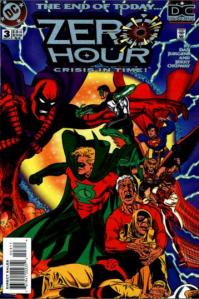 Zero Hour is the story of the DCU vs. Extant. Sort of? Yeah, this is one of those books where they tried to get as much shit to happen in as few pages as possible. Here’s the best way I can explain it. During Armageddon 2001 (which almost deserves a “WTF Is” of its own), a character named Waverider goes back in time to the year 2001 to try and destroy an evil being named the Monarch before he can kill all the superheroes around 2030. During that event, the Monarch captured Hank “Hawk” Hall and Dawn “Dove” Granger, eventually executing Dove and making Hank go crazy. The Monarch then revealed himself to be a future version of Hank, driving Hank to kill the Monarch, steal his armor, and take up the Monarch mantle himself (in other words, he does everything in his stupid power to make sure that he ends up a bad guy). After becoming a Captain Atom villain for a while, it’s discovered that instead of the Monarch killing Dove, he just absorbed her or something. Hank Hall then changes his name to Extant, steals Waverider’s time travel bracelets, and disappears into time to try and change the universe into how he wants it by erasing existence from the end of time backwards to the beginning and restarting from scratch.
Zero Hour is the story of the DCU vs. Extant. Sort of? Yeah, this is one of those books where they tried to get as much shit to happen in as few pages as possible. Here’s the best way I can explain it. During Armageddon 2001 (which almost deserves a “WTF Is” of its own), a character named Waverider goes back in time to the year 2001 to try and destroy an evil being named the Monarch before he can kill all the superheroes around 2030. During that event, the Monarch captured Hank “Hawk” Hall and Dawn “Dove” Granger, eventually executing Dove and making Hank go crazy. The Monarch then revealed himself to be a future version of Hank, driving Hank to kill the Monarch, steal his armor, and take up the Monarch mantle himself (in other words, he does everything in his stupid power to make sure that he ends up a bad guy). After becoming a Captain Atom villain for a while, it’s discovered that instead of the Monarch killing Dove, he just absorbed her or something. Hank Hall then changes his name to Extant, steals Waverider’s time travel bracelets, and disappears into time to try and change the universe into how he wants it by erasing existence from the end of time backwards to the beginning and restarting from scratch.
So, yeah, what we have here is another DC “crisis” event attempting to once again change the DCU forever by throwing a ton of confusing shit at us all at once and hoping that in the end it all makes sense. To make matters worse, Zero Hour was written by Dan Jurgens, the guy behind Superman vs. Aliens, the “Death of Superman” storyline, and the creator of DC’s Tangent imprint. Also included in the storyline are a bunch of tie-ins that were all released in October 1994 and numbered #0 (also known as “Zero Month”) which each revealed something unknown about the main hero of the title’s origin. Basically, this is everything amiss with 1990s DC Comics. Brace yourselves.
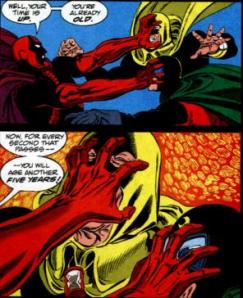 So, here is the quickest summary I can muster. Extant travels to the end of time, killing Time Trapper and causing a Crisis on Infinite Earths-style Ctrl+Z rift to go backwards through time, erasing existence (don’t think about the physics of this, it makes zero sense). Metron, Waverider, Superman, and Batman team up to attempt to stop the universe from rebooting. They get the help of every other hero in the DCU and the results are somewhat catastrophic. Wally West, Jay Garrick, Steel, most of the JSA, Dr. Mist, Vandal Savage, the Legion of Super-Heroes, and Kyle Rayner all “die.” An attempt is made at explaining what Hawkman’s deal is by stuffing all of the Thanagarians into one body (which just ends up raising more questions rather than clarifying anything). Extant is revealed to not really be the villain of the book, but was working for Hal Jordan (under the influence of Parallax) who wants to undo Coast City getting destroyed in “Reign of the Supermen.” The story ends with the universe being completely erased before the Spectre showing up to save the day (as he pretty much does in every Crisis) and the Green Arrow shooting Hal in the chest, “killing” him. The Spectre pumps newcomer Damage full of energy, causing him to act as a new Big Bang. Time goes by naturally and the universe is as it was. Sort of.
So, here is the quickest summary I can muster. Extant travels to the end of time, killing Time Trapper and causing a Crisis on Infinite Earths-style Ctrl+Z rift to go backwards through time, erasing existence (don’t think about the physics of this, it makes zero sense). Metron, Waverider, Superman, and Batman team up to attempt to stop the universe from rebooting. They get the help of every other hero in the DCU and the results are somewhat catastrophic. Wally West, Jay Garrick, Steel, most of the JSA, Dr. Mist, Vandal Savage, the Legion of Super-Heroes, and Kyle Rayner all “die.” An attempt is made at explaining what Hawkman’s deal is by stuffing all of the Thanagarians into one body (which just ends up raising more questions rather than clarifying anything). Extant is revealed to not really be the villain of the book, but was working for Hal Jordan (under the influence of Parallax) who wants to undo Coast City getting destroyed in “Reign of the Supermen.” The story ends with the universe being completely erased before the Spectre showing up to save the day (as he pretty much does in every Crisis) and the Green Arrow shooting Hal in the chest, “killing” him. The Spectre pumps newcomer Damage full of energy, causing him to act as a new Big Bang. Time goes by naturally and the universe is as it was. Sort of.
But how is this still relevant to the modern DCU? Well, remember when I said all of those characters “died?” The only ones who actually died and stayed dead were the original Atom and Doctor Mid-Nite. Wally West just got thrown through the time stream a bit, where he witnessed all the major points in his life (including his and Linda’s deaths) and gave a younger self a pep talk. Hal Jordan and Kyle Rayner didn’t really die, but got transported back to Oa. There, they had an all out fight that ended with Oa getting blown the fuck up. Aquaman got his totally 90s beard and harpoon hand after piranhas ate it off. Power Girl has a baby which is pretty much never heard from again. The biggest impact, however, was probably to Green Arrow. Thinking that he’d just killed Hal Jordan, Ollie threw his costume into the sea, went back to the monastery he joined in Flash #218, and meets Connor Hawke, his son, for the first time.
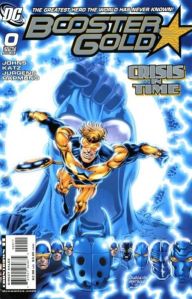 Some of the strangest tie-ins, however, had to be in both Neil Gaiman’s Sandman and Geoff Johns’ Booster Gold. In Sandman: Worlds’ End, a group of inter-dimensional travelers sit in a bizarre inn and wait out the “reality storm” caused by Parallax in Zero Hour (without ever directly mentioning it). Even stranger is April 2008’s Booster Gold #0, in which Booster, Dan Gerrett, Ted Kord, Jamie Reyes, and an unnamed fourth Blue Beetle from the 57th century stumble across Extant and Parallax discussing why they didn’t want Alan Scott dead. After a brief fight, Booster and the Beetles (ha) zap themselves away to the time of Booster’s origin, making its premise similar to the #0 books of 14 years prior.
Some of the strangest tie-ins, however, had to be in both Neil Gaiman’s Sandman and Geoff Johns’ Booster Gold. In Sandman: Worlds’ End, a group of inter-dimensional travelers sit in a bizarre inn and wait out the “reality storm” caused by Parallax in Zero Hour (without ever directly mentioning it). Even stranger is April 2008’s Booster Gold #0, in which Booster, Dan Gerrett, Ted Kord, Jamie Reyes, and an unnamed fourth Blue Beetle from the 57th century stumble across Extant and Parallax discussing why they didn’t want Alan Scott dead. After a brief fight, Booster and the Beetles (ha) zap themselves away to the time of Booster’s origin, making its premise similar to the #0 books of 14 years prior.
Anyways, congratulations, whoever you are! You are now an expert in all things Zero Hour and never, ever have to read it.
 Normally, I’m a pretty open minded dude. You’d be pretty hard pressed to mention something to me that either puts me off or grosses me out. But, I’ll be damned, it turns out that DC Comics figured out how to do it through one of its Silver Age characters, Comet the Super-Horse.
Normally, I’m a pretty open minded dude. You’d be pretty hard pressed to mention something to me that either puts me off or grosses me out. But, I’ll be damned, it turns out that DC Comics figured out how to do it through one of its Silver Age characters, Comet the Super-Horse.
Comet was a by-product of DC’s love affair with slapping the “super” prefix on any and every animal they could think of (see: Streaky, Krypto, Beppo), except he had one big, big difference. You see, Comet wasn’t always a horse. In the beginning, Comet was a Greek centaur named Biron who was crazy in love with Circe. One day he spotted a rival wizard, Maldor, trying to poison the well she drank from. Biron ended up saving her life and, as a reward, she decided to use her powers of transforming people into animals and tried to turn Biron into a man. Instead, she done fucked up something fierce and he ended up being all horse. As 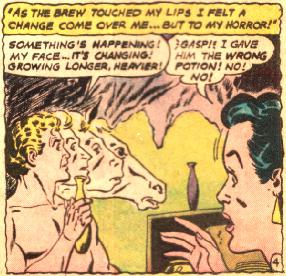 a consolation prize, she gave him a shit-ton of superpowers including flight, super strength, immortality, and telepathy. He blasted off into space and eventually caught sight of Supergirl’s rocket blasting through space. I guess being a space-horse is boring enough, so he followed her to Earth and watched her grow up to be Supergirl. Also, his ass fell in looooove.
a consolation prize, she gave him a shit-ton of superpowers including flight, super strength, immortality, and telepathy. He blasted off into space and eventually caught sight of Supergirl’s rocket blasting through space. I guess being a space-horse is boring enough, so he followed her to Earth and watched her grow up to be Supergirl. Also, his ass fell in looooove.
Later on, in September 1962’s Action Comics #292 (his first printed appearance), he decides to telepathically invade her dreams (if that doesn’t throw some serious creepy vibes your way, I dunno what will). She ends up vacationing at a Supergirl-themed dude ranch (which makes no sense) and, holy shit, Comet just happens to be one of the horses. They become fast buddies and shenanigans ensue. In Action Comics #311, Superman asks Comet to travel to the red-sunned “sorcerer’s planet” Zerox to do their ruler, Prince Endor, a favor. In return, Endor grants him the ability turn into a powerless human anytime a comet goes through our solar system. And what does Comet do when he happens to get home just as a comet is zooming past? He enters a rodeo under the name Bronco Bill  Starr, gets saved from a bull by Supergirl, and macks on her like there’s no tomorrow.
Starr, gets saved from a bull by Supergirl, and macks on her like there’s no tomorrow.
He ran around with the Legion of Super-Pets and kept on helping out Supergirl (usually with his telepathic powers) until his last appearance in April 1970’s Adventure Comics #392. Well, sorta last appearance. There’s some dude with horse DNA going by the name Comet who debuted in late-1990’s Supergirl, but he’s so different/idiotic that I don’t think they’re really related. He also popped up as a statue in a museum in Legion of Three Worlds #1, but that was probably just a Geoff Johns-style tip of the hat (although, you know Sterling Gates, modern Supergirl does seem to be missing something).
I guess technically Comet only got down with Supergirl when he was human, but you know what? There’s still that little thing in the back of your head going, “Hey. He’s a horse. And even when he wasn’t a horse,  from the waist down, he was still a fucking horse.” Let that simmer. What would happen if “Bill Starr” hooked up with Supergirl and he ended up turning back into Mr. Ed? That’s, like, that Catherine the Great legend times a bajillion (also, ew). Anyways, enjoy having that visual for the rest of your life.
from the waist down, he was still a fucking horse.” Let that simmer. What would happen if “Bill Starr” hooked up with Supergirl and he ended up turning back into Mr. Ed? That’s, like, that Catherine the Great legend times a bajillion (also, ew). Anyways, enjoy having that visual for the rest of your life.
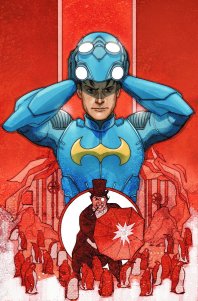 Ever since World’s Finest debuted in 1941, DC Comics has had a comic chubby for Superman/Batman team-ups. I mean, granted, they go well together what with all the differences between Bruce and Clark. But when I heard DC’s plan to bring back a World’s Finest limited series I was confused. I mean, Bruce is dead (sort of) and Clark is busy soldiering on New Krypton. So, how the hell do you showcase the world’s finest team-up when the world’s finest are kind of, well, anything but?
Ever since World’s Finest debuted in 1941, DC Comics has had a comic chubby for Superman/Batman team-ups. I mean, granted, they go well together what with all the differences between Bruce and Clark. But when I heard DC’s plan to bring back a World’s Finest limited series I was confused. I mean, Bruce is dead (sort of) and Clark is busy soldiering on New Krypton. So, how the hell do you showcase the world’s finest team-up when the world’s finest are kind of, well, anything but?
Apparently, Sterling Gates figured it how to pull this one off. Just because the main heroes are a tad predisposed, it doesn’t mean the other characters from their respective corners of the DCU can’t mingle a bit. Even better, Gates manages to pull out some of the lesser used heroes; 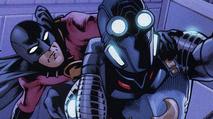 case in point, issue one teams up Red Robin and Nightwing (the Kryptonian son of Zod, not Dick Grayson). World’s Finest #1 is all about the duo trying to rescue a kidnapped Flamebird (Nightwing’s partner/girlfriend) from the combined clutches of the Penguin and the Kryptonite Man, who are looking to sell her to the highest bidder (yeah, that’s pretty fucking creepy).
case in point, issue one teams up Red Robin and Nightwing (the Kryptonian son of Zod, not Dick Grayson). World’s Finest #1 is all about the duo trying to rescue a kidnapped Flamebird (Nightwing’s partner/girlfriend) from the combined clutches of the Penguin and the Kryptonite Man, who are looking to sell her to the highest bidder (yeah, that’s pretty fucking creepy).
There’s more talk than action throughout most of the book, with a lot of chatter between either Red Robin and Nightwing or the Penguin and his cohorts. I’m usually bored to tears by an overly chatty book, but Gates manages to keep this book moving, even with a lot of dialogue. Actually, my only complaint was with Julian Lopez’s art, which occasionally felt a bit 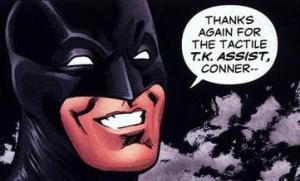 goofy. There’s one panel in particular of Red Robin with this giant grin lifted from a Golden Age comic. Yes, I understand he thought Nightwing was Conner and he was psyched for a team-up but, man, the guy is trying to solve his adoptive dad’s murder. Considering how pissed off Tim seems directly before and after this panel, the grin seems almost inappropriate. But that’s just me.
goofy. There’s one panel in particular of Red Robin with this giant grin lifted from a Golden Age comic. Yes, I understand he thought Nightwing was Conner and he was psyched for a team-up but, man, the guy is trying to solve his adoptive dad’s murder. Considering how pissed off Tim seems directly before and after this panel, the grin seems almost inappropriate. But that’s just me.
What the hell though, I’m going to go ahead and recommend this book. I’m excited for the other three upcoming team-ups (Damien Wayne and the Guardian, Stephanie Brown and Supergirl, and the first ever Dick Grayson Batman / Superman pairing) and issue one did have an interesting cliffhanger at the end. Slow starts be damned, I have a feeling that this book is seriously going to pay off in the end.

